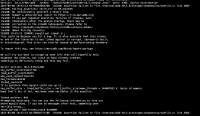Details
-
Bug
-
Status: Closed (View Workflow)
-
Blocker
-
Resolution: Fixed
-
10.5.9
-
None
-
[root@localhost~]# cat /etc/redhat-release
CentOS Linux release 7.8.2003 (Core)
[root@localhost~]# uname -r
4.14.105-19-0013
[root@localhost~]# lscpu
Architecture: x86_64
CPU op-mode(s): 32-bit, 64-bit
Byte Order: Little Endian
CPU(s): 48
On-line CPU(s) list: 0-47
Thread(s) per core: 2
Core(s) per socket: 12
Socket(s): 2
NUMA node(s): 2
Vendor ID: GenuineIntel
CPU family: 6
Model: 85
Model name: Intel(R) Xeon(R) Gold 6126 CPU @ 2.60GHz
[root@localhost~]# free -g
total used free shared buff/cache available
Mem: 125 46 42 1 35 75
Swap: 3 0 3
The SSD device is Intel P4610 3.2TB and the database version is MariaDB 10.5.9 Community Edition[ root@localhost ~]# cat /etc/redhat-release CentOS Linux release 7.8.2003 (Core) [ root@localhost ~]# uname -r 4.14.105-19-0013 [ root@localhost ~]# lscpu Architecture: x86_64 CPU op-mode(s): 32-bit, 64-bit Byte Order: Little Endian CPU(s): 48 On-line CPU(s) list: 0-47 Thread(s) per core: 2 Core(s) per socket: 12 Socket(s): 2 NUMA node(s): 2 Vendor ID: GenuineIntel CPU family: 6 Model: 85 Model name: Intel(R) Xeon(R) Gold 6126 CPU @ 2.60GHz [ root@localhost ~]# free -g total used free shared buff/cache available Mem: 125 46 42 1 35 75 Swap: 3 0 3 The SSD device is Intel P4610 3.2TB and the database version is MariaDB 10.5.9 Community Edition
Description
Repeat steps are as follows (100% reproducible) :
1. Run the Sysbench benchmark using either Intel P4610 or ScaleFlux CSD 2000 and set the logical sector to 4K (take Intel P4610 as an example below)
[root@localhost~]# isdct start -intelssd 0 -nvmeformat LBAFormat=1
[root@localhost~]# nvme list
Node SN Model Namespace Usage Format FW Rev
---------------- -------------------- ---------------------------------------- --------- -------------------------- ---------------- --------
/dev/nvme0n1 PHLJ8230004W4P0DXX INTEL SSDPE2KX040XX 1 3.84 TB / 3.84 TB 4 KiB + 0 B VDV10131
2. Use the ext4 file system to format and mount the Intel P4610
[root@localhost~]# mkfs.ext4 /dev/nvme0n1
[root@localhost~]# mount /dev/nvme0n1 -o discard /data/nvme0n1
3. Use the binary tar package of MariaDB 10.5.9 to initialize the installation (steps are abbreviated). The configuration options are as follows
[client]
socket=/data/sfdv0n1/mariadb-10.5.9/mysql.sock
[mysqld_safe]
user=mysql
log_error=/data/sfdv0n1/mariadb-10.5.9/error.log
[mysqld]
socket=/data/sfdv0n1/mariadb-10.5.9/mysql.sock
datadir=/data/sfdv0n1/mariadb-10.5.9
basedir=/opt/app/mariadb-10.5.9
user=mysql
log_error=/data/sfdv0n1/mariadb-10.5.9/error.log
explicit_defaults_for_timestamp=1
innodb_page_size=16384
innodb_buffer_pool_size =32G
innodb_buffer_pool_instances=8
innodb_page_cleaners=8
innodb_log_file_size =8G
innodb_log_buffer_size = 128M
innodb_flush_log_at_trx_commit=1
innodb_thread_concurrency=0
innodb_open_files=100000
innodb_file_per_table=1
innodb_flush_method=O_DIRECT
innodb_change_buffering=all
innodb_adaptive_flushing=1
innodb_old_blocks_time=1000
innodb_use_native_aio=1
innodb_lock_wait_timeout=120
lock_wait_timeout=60
innodb_io_capacity_max = 100000
innodb_flush_neighbors = 0
innodb_log_write_ahead_size=8192
innodb_doublewrite=1
innodb_compression_algorithm=zlib
max_connections=65536
max_prepared_stmt_count=1048576
4. Running sysbench requires more than 20GB of data to be written to disk. The sysbench command looks like this
[root@localhost~]# sysbench --db-driver=mysql --time=900 --threads=16 --report-interval=1 --mysql-socket=/data/sfdv0n1/mariadb-10.5.9/mysql.sock --mysql-user=qbench --mysql-password=qbench --mysql-db=sysbench --tables=32 --table-size=20000000 oltp_read_write --db-ps-mode=disable --percentile=99 --mysql-ignore-errors=1062,1213 --mysql_storage_engine=innodb --create_table_options="page_compressed=1" --rand-type=uniform prepare
5. After a minute or so, the sysbench tells you that the connection is broken. If you look at the MariaDB error log, you can see a crash prompt similar to the one shown in the figure below
PS: if the logic of SSD equipment sector is set to 512 bytes, will not appear afore-mentioned crash phenomenon, we again in many different servers, once the logical sector is set to 4 k of SSD equipment, enabling the page compression would be a collapse of the Server process, and once the logic of SSD equipment sector is set to 512 bytes, enable page compression will not appear the phenomenon of Server process crashes, seems page compression of SSD equipment 4 k logical sector support not friendly enough?
Attachments
Issue Links
- relates to
-
MDEV-16328 ALTER TABLE…page_compression_level should not rebuild table
-
- Closed
-
-
MDEV-21584 Linux aio returned OS error 22
-
- Closed
-
-
MDEV-26040 os_file_set_size() may not work on O_DIRECT files
-
- Closed
-
-
MDEV-16264 Implement a common work queue for InnoDB background tasks
-
- Closed
-
